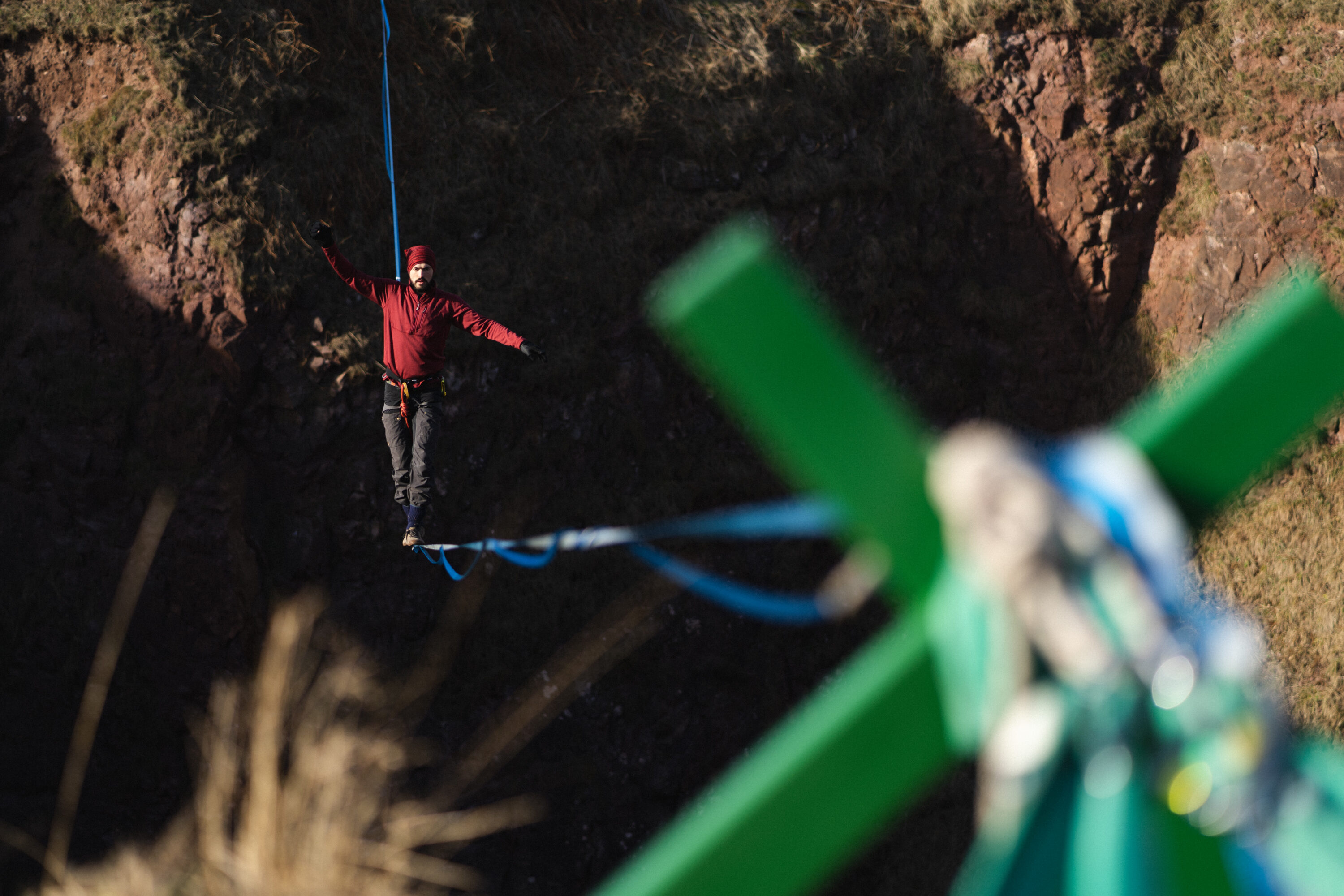
Home Story Between Sea and Sky
Between Sea and Sky
Feature type Story
Read time 8 mins
Published Mar 15, 2022
Author Hannah Mitchell
Photographer Owen Hope
The fundamentals of highlining are pretty straightforward. Between two fixed anchor points, rig a narrow length of flat webbing suspended above the ground across a gap and traverse the line from one side to the other without falling. Balance and bravery are obvious requirements, but there’s much more behind this seemingly high-stakes activity than it may at first seem.
In February 2022, a team including photographer and experienced highliner Owen Hope rigged two vast lines, bridging faults on the east coast of Scotland – the Gaylet Pot and Arbroath Cliff lines. We catch up with Owen, for a closer look at the risk management, artistry of assembling, walking and photographing these homeland highlines.

One-Time lines
The red sandstone Arbroath Cliffs are an imposing feature on the east coast of Scotland. Just metres inland of these cliffs lies Gaylet Pot, a yawning, tidal chasm, about a mile south of the village of Auchmithie. A popular spot with daring kayakers – at high tide in busy seas, seawater surges upwards into the chamber, creating a roaring dramatic blow-hole as salt and spray erupt from this gaping hole in the earth.
This rugged coastline, with its iconic cliffs and wide open basin, provided the perfect locations for two separate lines. Over the course of ten days in February 2022, Owen Hope, Owain Taylor, Aidan Lynch and Ewan Suitor, who met at university in St. Andrews, along with Edinburgh-based Rowan Pocock, Amar Dhawan and Mike Chan made up the meticulous team that rigged and walked these once-in-a-lifetime lines.
We rigged the line, walked it and had a great day, but we won’t return. In a way, I think that actually makes it more special
The mouth of Gaylet Pot opens up in a field alongside the Auchmithie-Arbroath coastal path. It was on this patch of windswept farmland that the team placed the anchor points that would support the Gaylet Pot line, bridging a gap of 60 metres, suspended around 50 metres above the North Sea.
‘As a team, we’re largely aligned in our desire to walk through the airspace of beautiful places,’ says Owen. ‘Gaylet Pot as a location is stellar. It’s effectively a big hole in the ground with a beach at the bottom, waves crash up onto the beach, coming through an underground tunnel from the sea. We were there just one day and both myself and Rowan walked the entire line, back-and-forth, multiple times.’
Along the same stretch of coastline, the line the group rigged at Arbroath Cliff was comparatively monstrous in stature. At 140m, it’s another example of Scotland’s relatively unexplored highlining potential.

‘Arbroath is quite different to a lot of the highlining I’ve done in the past,’ says Owen. ‘Before this, the only coastal highline I’d been involved with was from the Old Man of Stoer to the mainland. Whilst Arbroath was visually less epic than that line, it was the first ever rigged and walked between the Arbroath Sea Cliffs.’
Owing to its position on farmland though, once the team had rigged, walked and dismantled the Gaylet Pot line, it was politely requested that they not return to the same spot. After a respectful conversation between the team and the landowner it was agreed they’d not rig there again.
‘For obvious reasons, we really don’t advocate any other teams either climbing or highlining here again,’ Owen explains. ‘We rigged the line, walked it and had a great day, but we won’t return. In a way, I think that actually makes it more special.’

High Stakes
Lines such as these are rigged with military precision, taking into account a staggering amount of detail in selecting the appropriate anchors for the location. Both the Gaylet Pot and Arbroath Cliff lines were fixed using MOD-issue steel ground stakes as anchors.
‘Location scouting depends on the availability of anchors,’ says Owen. ‘Picking anchors is more or less life-or-death as the integrity of your anchors largely dictates that of your rigging. We are especially calculated with our approach and base this on rigorous scientific testing and academic, peer-reviewed data.’
Highlining, like many other adventure activities and sports, is of course not without risk. Whilst to the outsider it might appear to be a high-stakes hobby, seductive for thrill-seekers and adrenaline junkies, the reality is something far more calculated.
‘Yes we encounter risks, as does any individual navigating everyday life,’ he says. ‘We engage with situations that if not handled properly, could result in injury or death – no different to someone operating an oven or a car. We don’t undertake any kind of highline-related activity that’s more dangerous than driving to the location, a task involving considerably more statistical and conceptual risk.’
Very few highlines have been established here without our efforts, we feel as though we have an empty canvas

Home Turf
Having previously rigged lines in locations he had explored as a child –closer to where he grew up around Inverness – travelling a little further afield, it was climbing at Arbroath when the location’s highlining potential initially caught Owen’s attention.
‘Arbroath has the obvious quality of an impressive coastal atmosphere, combined with sufficient anchor spots, height and accessibility,’ he explains. ‘I don’t wish to claim that Scotland is distinctly better for highlining than anywhere else, there are incredible opportunities all over the planet. But as a team, we all agree that Scotland’s geographical characteristics make much of its coastline particularly appealing.’
Experiencing the location both physically and through the lens, as a photographer, Owen finds himself even more attuned to the fine details of each set-up and location.
‘Sometimes we spend days in the same spot,’ he says. ‘Photographing these adventures enhances the experience even more – you become so familiar with the minute details, as well as the unique way the light affects each location.’

Finding Balance
Whilst soil and science are of paramount importance in the early stages of assessing a location’s individual highlining suitability, the atmosphere, scenery and surrounds are key elements in the physical experience of actually walking the line. Finding the spot for the perfect line means striking balance in all these things.
‘Location is really important. Rigging and walking highlines for us is a way of experiencing a place in a truly unique way,’ he says. ‘I do think though, that you can become a bit obsessed. Sometimes I struggle to fully engage with a great location, when in the back of my mind I know that highlining there would be the ultimate experience!’
As it stands, Scotland remains somewhat unchartered territory when it comes to highlining. And whilst some of the other members of Owen’s team have rigged and walked highlines throughout Europe and even further afield, the unique charm of Scotland’s untrodden airspaces both inland and on the coast is more than enough to keep them busy at home.
‘Scotland is still relatively unexplored in terms of highlining,’ says Owen. ‘Very few highlines have been established here without our efforts, so we feel as though we have an empty canvas to play with.’
Don’t miss a single adventure
Sign up to our free newsletter and get a weekly BASE hit to your inbox
Other posts by this author

Story • Hannah Mitchell • Jul 28, 2023
Reframe, Engage, Create Change
How Arc'teryx's ReBIRD program is engaging consumers with the concept of circularity in the outdoor clothing industry

Story • Hannah Mitchell • Jun 27, 2023
The UK’s Best ‘Almost Wild Camping’ Spots For 2023
Back-to-basics camping and wild vibes... but with a few added comforts

Interview • Hannah Mitchell • Jun 13, 2023
Chasing The 14: The Kristin Harila Interview
In conversation with record-breaking Norwegian mountaineer and Osprey ambassador, Kristin Harila

You might also like

Story • Owen Hope • Aug 24, 2022
How We Rigged The Longest HighLine in Scotland
A fresh-faced crew take on the Sow of Atholl rigging a 320m line high above the valley below



